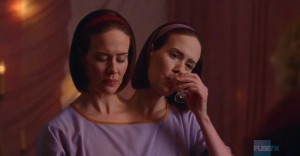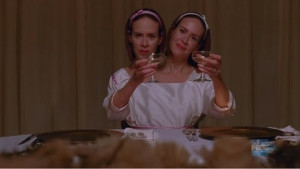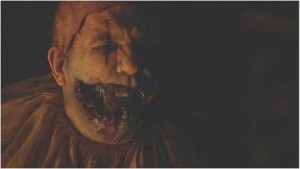
Nominated for Marvel’s Agents of S.H.I.E.L.D. for the second straight year, and for American Horror Story: Freak Show, FuseFX artists and supervisors will head to the 67th Emmy Awards ceremony on Sept. 20 buffeted by the aura of the FX cult hit’s 18 additional nominations. “AHS has such a cachet right now, creatively, across the board,” said FuseFX CEO Dave Altenau. “The production values are so good that we’re just thrilled to be part of it. The show is very organic and oriented toward practical effects, so a lot of our work is very nuanced. Over the years, show creator and executive producer Ryan Murphy has gained confidence with our ability to contribute digital work within that very stylized world. And because there were more substantial visual effects that production committed to early on in this season, especially in terms of the twins and Twisty the Clown’s face replacement, our team is feeling really positive about the nomination.”
Actress Sarah Paulson is already a Critics Choice Television Award winner for her sweet and saucy Southern-tinged portrayal of conjoined twins Dot and Bette Tattler and received her third Emmy nomination for her work on the show. Altenau helped develop the compositing techniques used to blend Paulson’s dual performances, filmed in alternate takes of the same scene. “The whole concept of Dot and Bette was daunting right from the beginning,” he said. “We didn’t want to create any severe production constraints on how to set up this kind of effect on set, and we knew we were already constrained by tight television turnarounds. We all certainly tested the limits as we went. The most challenging part was figuring out how they could give us what we needed visually to pull off the scene’s effect, with confidence, without that slowing anybody else down.”
 Integrating the two different passes so that Paulson’s body looked and moved consistently from frame to frame still brought fresh hurdles in post, he added. “The two shots were never identical. Lighting would change, perspective would vary and camera moves would vary. Once we got a rhythm going we got better and faster at blending the two as the season progressed.” The full range of effects completed for the show included digital environments, matte paintings, face and body replacements and digital doubles, and plenty of pyrotechnics that sizzled and popped into the shows tented, dark night.
Integrating the two different passes so that Paulson’s body looked and moved consistently from frame to frame still brought fresh hurdles in post, he added. “The two shots were never identical. Lighting would change, perspective would vary and camera moves would vary. Once we got a rhythm going we got better and faster at blending the two as the season progressed.” The full range of effects completed for the show included digital environments, matte paintings, face and body replacements and digital doubles, and plenty of pyrotechnics that sizzled and popped into the shows tented, dark night.
Altenau said that the collective experience of his shop across the various facilities is the main reason FuseFX can pull off that kind of double hat trick – believable, story-driven VFX delivered at an episodic pace. “From day one, I never wanted to experiment with hiring less experienced people that we’d have to train,” he said. “The average experience on any given seat in our shop is probably 15 years. Our staff brings incredible experience from ILM, Digital Domain, Zoic and Rhythm & Hues. But we also have several television veterans.” A proprietary pipeline, developed to encompass everything from shot management to the way shots are moved by leads throughout the system, lets the facility achieve the highest level effects they can on brutal television schedules. “It starts with the core talent set of our artists but we’ve got a super efficient workflow that gives us a lot more predictability and confidence to move really hard work, and a lot of it, through here at a very fast pace.”
VFX supervisor Jason Piccioni — who shares the Emmy nomination for American Horror Story: Freak Show‘s episode “Edward Mordrake, Part 2″ with Altenau, visual effects producers Jason Spratt and Tim Jacobsen, lead compositor Tommy Tran, lead CG artist Mike Kirylo, CG artist Matt Lefferts, production VFX supervisor Justin Ball and SFX supervisor Donnie Dean — was FuseFX’s first full-time supervisor on staff. “He’s just a really incredible talent in the way he works with clients and develops creative processes that don’t just work but elevate the resulting effects to exciting new levels,” said Altenau.

“Every scene had so many layers to it,” added VFX supervisor Jason Piccioni. “A ton of hair, make-up, coupled with the strains on the actors and the crew who have to perform and film really difficult scenes. It becomes a real labor of love for all of us to get those scenes out to where we expect them to be. Ryan Murphy told us at the beginning of production that he didn’t think anyone had ever accomplished anything like two-headed conjoined twins before on television. It was a very worthy goal. But Sarah had her own struggles with performing something like that on set. And we still had to post those episodes in about a week — ingesting on a Friday, getting roughs back to Ryan by Monday or Tuesday, and the show delivering by Thursday.” Piccioni said he realized when watching Paulson’s scenes, as well as the final comped confrontation between character Edward Mordrake, who also has a face on the back of his head, and Twisty with his own complicated facial effects, the digital and artistic bar had reached a new level. “A few years ago, you wouldn’t have even been able to contemplate any of this on television,” he said.
FuseFx is already developing its shot list as the next season of American Horror Story begins production. Veering sharply into post-modern Stephen King territory, the new season is set at a sinister hotel and features a star turn by new cast member Lady Gaga.
FuseFX team members joining their colleagues on Sept. 20 at the Emmys include visual effects supervisor Mark Kolpack, VFX producer Tracy Takahashi, compositing supervisor Kevin Lingenfelser, CG supervisor Matthew Von Brock, CG lead artist Mitch Gates, lead compositor Kevin Yuille, VFX coordinator Briana Aeby, production lead VFX producer Sabrina M. Arnold and special effects supervisor Gary D’Amico, all nominated for the outstanding visual effects Emmy for Marvel’s Agent of S.H.I.E.L.D. episode “The Dirty Half Dozen.”





